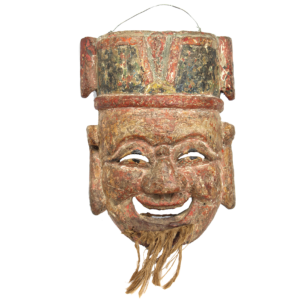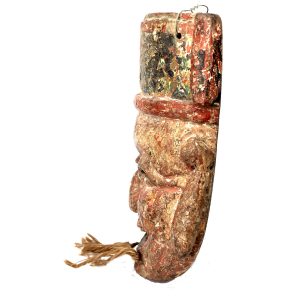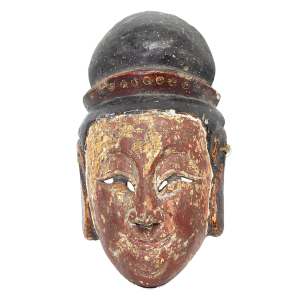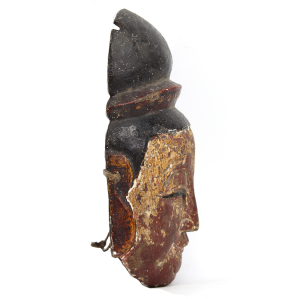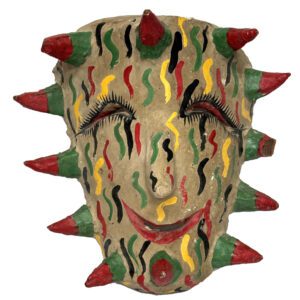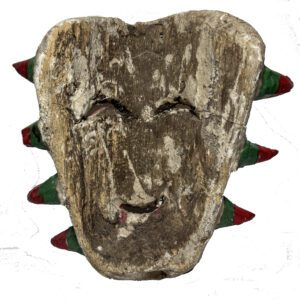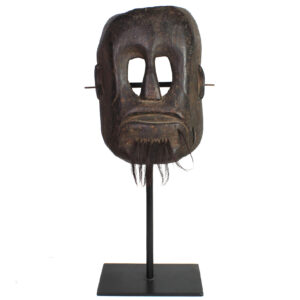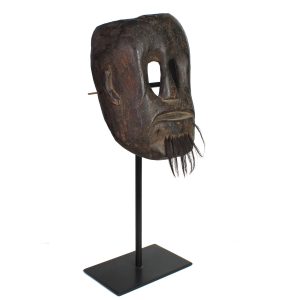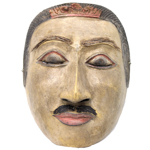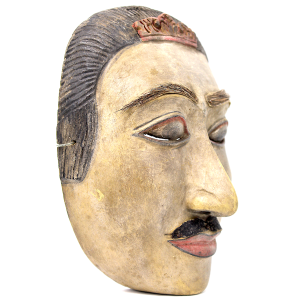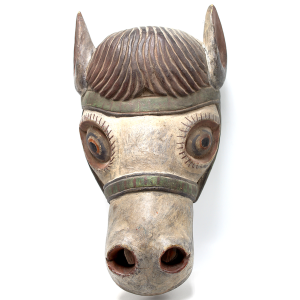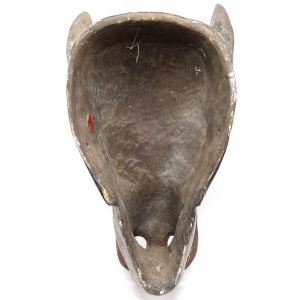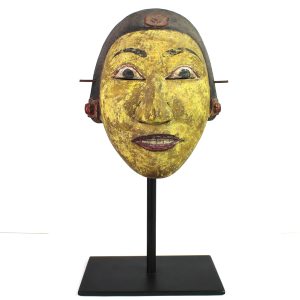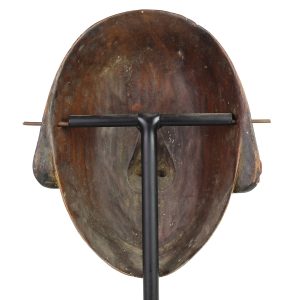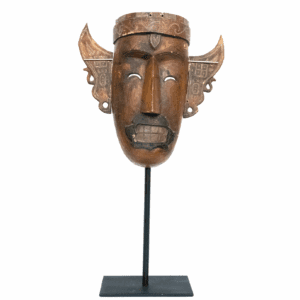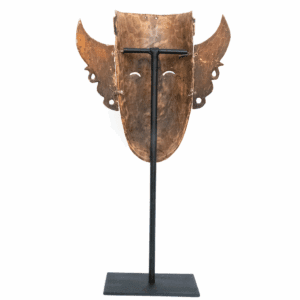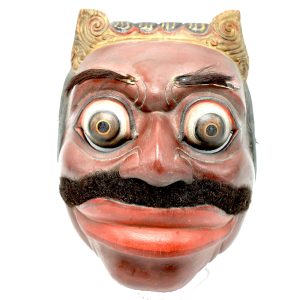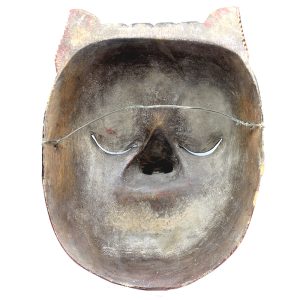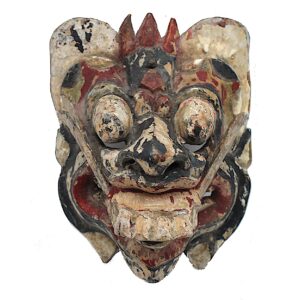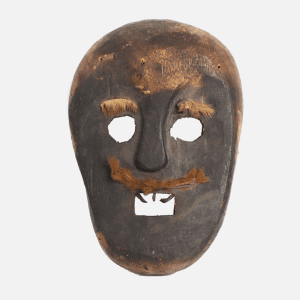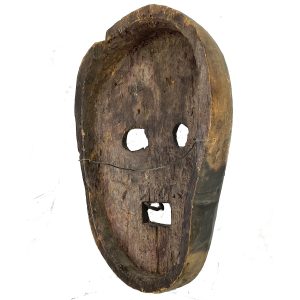Showing 1–12 of 14 results
-
Sale!


$595.00 Original price was: $595.00.$475.00Current price is: $475.00.
H: 10.5” W:7.75” D: 3” | FREE SHIPPING WITHIN CONTINENTAL US
This antique Nuo Opera mask is Tudi Gong, benevolent Earth god with smiling animated face, long eyebrows, hemp beard and high decorative hat. With an honest gentle disposition, he symbolizing the power of good to defeat evil. Nuo popular in Ming/ Qing dynasties, there are few remaining troupes.
-
Sale!


$395.00 Original price was: $395.00.$325.00Current price is: $325.00.
H: 9.25″ W: 5.75″ D: 2.25″ | FREE SHIPPING WITHIN CONTINENTAL U.S.
Chinese Noa opera mask is likely a female zhengshen – a benevolent gods with kind and honest nature and gentle disposition -symbolizing the power of good to defeat evil. Age and heavy use
-
Sale!


$90.00 Original price was: $90.00.$60.00Current price is: $60.00.
This Mexican folk art mask is a decorative version of a traditional dance mask representing a devil (el diablo) or a horned animal like a goat (chivo). The carved wood has a beige base with several red-tipped conical spikes or horns on the forehead, cheeks, and chin. Its vibrant appearance is enhanced with colorful, wavy lines in red, green, and…
-
Sale!


$1,750.00 Original price was: $1,750.00.$1,350.00Current price is: $1,350.00.
H: 20.75″ W: 8″ | CALL 213-568-3030 OR EMAIL [email protected] FOR SHIPPING
Rare Timor ancestor mask for ritual offerings to honor the departed and provide space during village visits, repel evil spirits. Featured in 2002 Spiderman movie in collection of the Green Goblin.
-


$105.00
This Dalem is a traditional folk-art and ethnic mask (topeng) from Bali made from pulai wood of a Hindu king (Dalem). He stares directly at the viewer while his high cheeks help express his poise and the ability to remain cool in a crisis. This is a fine example of a gifted carver able to…
-
Sale!


$325.00 Original price was: $325.00.$210.00Current price is: $210.00.
H: 13.5″ W: 7.5″ D: 5″ | FREE SHIPPING WITHIN CONTINENTAL U.S.
Used in ritual Cham Dances, this whimsical and colorful mask emphasizes the horses playful character, alertness and strength with large eyes, painted lashes, wide raised lids, flaring nostrils, open mouth and pointed ears framed by beautifully carved rows of black hair.
-
Sale!


$675.00 Original price was: $675.00.$525.00Current price is: $525.00.
Ht: 15.5” W: 8” D: 5” | CALL 213-568-3030 OR EMAIL [email protected] FOR SHIPPING
Dayu mask of Balinese high-caste female Hindu Brahman, beautiful decorative piece on a museum quality metal stand.
-
Sale!


$1,050.00 Original price was: $1,050.00.$895.00Current price is: $895.00.
H: 23.375” W: 13 W: 6” | FOR SHIPPING INFORMATION CONTACT US AT 213-568-3030 or [email protected]
Vintage animistic Dayak ancestor mask for agricultural festivals, separate wing-like decoratively painted ears, long nose, gnarled teeth, featured in Green Goblin’s collection in 2002 Spiderman movie.
-


$675.00
The religion of the ethnic Dayak (Dyak) people of Kalimantan (Borneo), Indonesia is a mix of animism, shamanism and ancestor worship. Their word hudoq describes three different things: it describes the pests that can destroy the rice harvest on which their survival depends; the name of the huge yearly Dyak planting celebration and the name…
-


$125.00
This ethnic and folk-art Bali legendary court minister (topeng patih) is performed in a special mask dance named Topeng Panjegan, as only one dancer interprets five different characters wearing full face masks preventing speech. Patih manis (Sweet Minister) is often the first solo dance after a gamelan orchestra introduction, and this patih keras (strong minister)…
-
Sale!


$395.00 Original price was: $395.00.$315.00Current price is: $315.00.
H: 6.3″ W: 4.8″ D: 2.5″ | FREE SHIPPING WITHIN CONTINENTAL U.S.
Rare Rangda mask from Indonesia island of Lombok made by Balinese Hindu craftsman is a child’s toy or mask used to teach child dancers cultural and artistic traditions. Made to instill fear with fangs, bulging eyes and protruding teeth. Missing lower fang indicate it was “de-commissioned.”
-
Sale!


$495.00 Original price was: $495.00.$325.00Current price is: $325.00.
H: 12.5″ W: 8.625″ D: 2.75″ | FREE SHIPPING WITHIN CONTINENTAL U.S.
Deeply set cut-out eyes and mouths are traditional for West Timor ancestor masks as are few, none or menacing teeth. They are rare and often have hair on animal hides on the upper lip, brows and head. Often looking threatening with stark features, their black color, teeth and often lack of balance scare off malevolent and evil spirits. Storing them in the rafters above the house hearth accounts for their smokey black color. Timor Ancestor masks have an earthy expressive presence and a raw spirit.
Timor’s religion has been described by Barbier as ritual exchanges between persons and social groups with their ancestors and fertility spirits. Timorese believe they can be upset by wicked forces, sickness, infertility and other forces, but particularly by the failure of the living to make suitable sacrifices to ancestral spirits. The departed protect and bring prosperity to the living as long as they are honored properly, so there is a close reciprocal link between the deceased and the secular world. Ancestors mediate between the living and the unseen world for living relatives. Their masks are used in animist veneration rituals, protective ceremonies and ritual dances or ceremonies tied to fertility, harvest, or funerary rites Besides masks, the living s are obliged to carve ancestor effigies to honor departed souls for them to occupy and rest in during their village visits. Many ceremonies usually occur in a house room known as “the womb” where a pillar supports beams rising up to the roof struts. This functions symbolically as an axis mundi (the center of the world or cosmic axis) that connects heaven and supports a simple altar above the floor to hold religious artifacts, protective fetishes and charms to ward off evil. So masks, effigies and fetish objects are protective and magic objects used throughout Indonesian islands in. Timor masks were rarely seen in the west until the mid-1970s.
End of content
End of content

